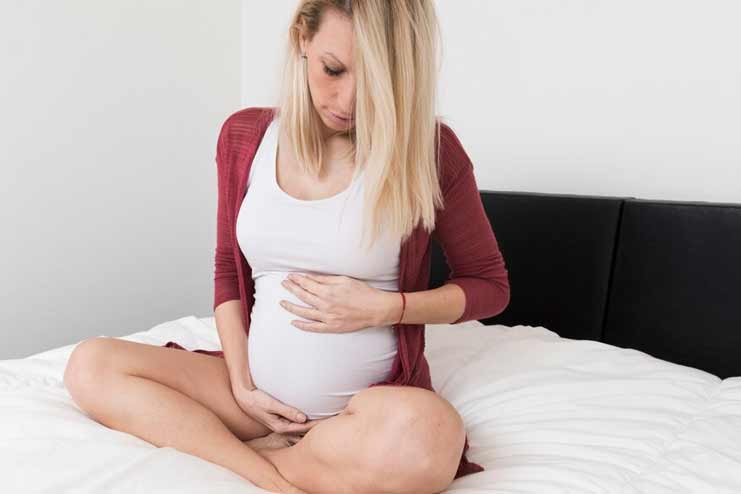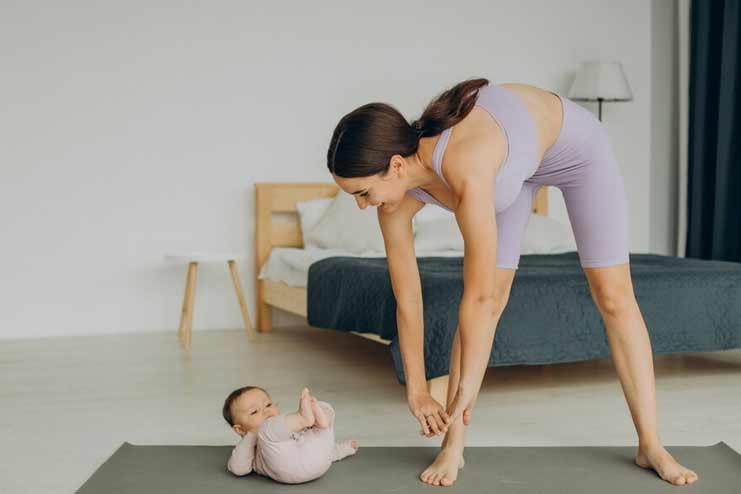Affiliate Disclaimer
Some links in this article are affiliate links. We may earn a small commission if you make a purchase through these links, at no extra cost to you. We only recommend products we find useful to our readersChildbirth brings about tremendous changes in a woman’s body, with the pelvic floor enduring a lot of strain. Postpartum pelvic health is of vital importance for post-childbirth recovery but is sometimes not a priority for new mothers and could lead to pelvic floor dysfunction.
Pelvic floor dysfunction affects most women and includes incontinence, pain, or muscle weakness. Taking care of your pelvic health after giving birth is extremely vital in speeding up the recovery process and preventing long-term complications.
In this article, we will discuss some of the best and most efficient ways to heal and restore your pelvic floor strength.
Pelvic Floor Changes After Childbirth

The pelvic floor is highly stressed during pregnancy and delivery, which leads to changes that affect postpartum recovery. Many women suffer from weakened pelvic muscles, a common reason for problems such as incontinence after childbirth. This occurs when there are tears or injuries to the muscles and tissue structures that support the bladder, uterus, and bowel.
Pelvic pain is another common complaint due to muscle strain or nerve damage during labor. Understanding these pelvic floor changes after childbirth is essential for recognizing symptoms and seeking the proper treatment to promote healing and restore its function.
Also, read: Understanding Pelvic Floor Disorders and Pain
Postpartum Healing Timeline

Though it usually follows a general pattern, the postpartum healing timeline varies depending on individual factors and the type of delivery.
Recovery for women who gave birth vaginally often focuses on healing perineal tears or episiotomies, with initial soreness lasting about 1-2 weeks. While full pelvic floor recovery may take months, swelling and discomfort usually go away in the first few weeks.
On the other hand, C-section recovery requires a more extended period for healing as this is a major surgery. Although the incision usually heals in 4-6 weeks, complete recovery of the abdominal and pelvic muscles may take several months.
It is important to understand this timeline in order to set realistic expectations and give your body enough time to heal completely.
Here’s a general timeline, but check with your doctor for timelines specific to you.
1–3 Days Postpartum:
- Cramping: Your uterus contracts to return to its normal size, causing “afterpains.” Even though it may hurt, this is a natural part of the healing process.
Weeks 1-2:
- Postpartum Bleeding and Discharge: During the first few weeks, vaginal bleeding (lochia) is common and should progressively stop. The discharge will transition from a bright red to a lighter hue, changing both in color and intensity.
- Mood and Mental Health: The “baby blues” are mood swings brought on by hormonal changes. Monitor these emotions and seek support from your doctor if they last longer than two weeks.
- Physical Recovery: Focus on gentle activities and get lots of rest. Use the prescribed pain relief meds to treat any discomfort resulting from C-section incisions.
- When to Start Exercising: You can start light exercise, like walking, a few days after giving birth or whenever you feel comfortable. Consult your doctor to be sure.
Weeks 3-4:
- Increase Activity: Gradually introduce light activities, such as short walks (10-15 minutes), to enhance circulation and boost energy levels.
- Focus on Nutrition: Hydration and a nutritious diet are essential to support healing and energy levels.
- Plan: To promote healing, start planning well-balanced meals and snacks.
Weeks 5-6:
- Pelvic Floor Exercises: Continue Kegel exercises and introduce gentle core-strengthening activities as tolerated.
- When to Increase Intensity: Most women can safely resume moderate exercise (like walking or swimming) by six weeks postpartum, depending on individual recovery. However, if you experienced complications or had a C-section, you may require additional time before beginning.
- Follow-Up Appointment: Schedule a postpartum check-up around week 6 to assess healing and address any ongoing concerns.
Weeks 7-12:
- Start Structured Exercise: After your 6-week check-up, you can begin gym programs with light weights as long as you avoid holding your breath and maintain proper posture. When the bleeding stops, you can resume exercises like aqua aerobics and swimming.
- Considerations: Your lower back and core abdominal muscles may be weaker than before. Avoid high-impact exercises or sports requiring rapid direction changes.
Months 3-4:
- Increase Activity Levels: If you feel ready, gradually increase the intensity of your workouts. If a physiotherapist evaluates your pelvic floor health, after 12 to 16 weeks confirming your improved health, you may advance to higher-impact activities like running and sports.
- Long-Term Health: To promote long-term pelvic health, prioritize a balanced diet and good lifestyle practices.
Months 4-6 and Beyond:
- Constant Monitoring: Increase the intensity of your workouts gradually. If there are any persistent issues, adjustments might be suggested.
- Exercise and Breastfeeding: To maintain hydration and calorie intake while breastfeeding, perform low- to moderate-intensity physical activities. Lactic acid buildup in breast milk from high-intensity exercise may influence the taste.
Warning Signs to Slow Down
Pay attention to your body and slow down if you experience any of the following:
- Increased fatigue
- Feeling unwell
- Muscle aches, strains, and pains
- Breast lumps or tenderness
- Changes in lochia color (postpartum vaginal flow) to pink or red
- Heavier lochia flow or if lochia starts flowing again after it has stopped
Exercises for Pelvic Floor Recovery

It is essential to include pelvic floor exercises postpartum to restore function and strength after childbirth. Kegels after childbirth are one of the best exercises, as they improve bladder control and reduce the risk of incontinence by contracting and relaxing the pelvic floor muscles. Kegel exercises involve tensing your muscles as if you are trying to stop or control your urine flow, holding the position for a short while, and then releasing the tension.
Other postpartum recovery exercises, like stretches and mild core-strengthening movements, can help prevent pelvic pain and improve overall muscle tone. You can promote long-term pelvic health and fasten the healing process by beginning these exercises as soon as your doctor recommends.
Some exercises to help heal your pelvic floor:
- Kegel Exercises: Tighten the pelvic floor muscles as though stopping your urine flow, hold for 5-10 seconds, then release. Repeat 10-15 times.
- Bridge Pose: Lie on your back in the bridge pose, with your feet flat on the ground and your knees bent. Raise your hips off the floor while using your core and pelvic floor muscles. After a brief period of holding, release. Repeat 10-15 times.
- Pelvic Tilts: Lie on your back with your knees bent. Using your abdominal muscles and tilting your pelvis upward, flatten your lower back against the floor. Hold for a few seconds and release. Repeat 10-15 times.
- Deep Breathing with Pelvic Floor Engagement: To practice diaphragmatic breathing, breathe deeply into your belly and gently contract your pelvic floor as you exhale.
- Side-Lying Leg Lifts: Lie on your side with your legs straight. While using your core and pelvic floor, raise your upper leg. Lower and repeat for 10-15 reps on each side.
When to Seek Medical Help

While some postpartum discomfort is normal, you must know when to see a doctor. Seek medical help for proper healing and long-term pelvic health if you experience any infection-related symptoms, such as fever or unusual discharge, or if your symptoms do not improve after a few weeks.
Incontinence, difficulty controlling bowel movements, or persistent postpartum pelvic pain could be signs of severe pelvic floor issues. A pelvic floor specialist will be able to assess your condition better and provide suitable treatment, including physical therapy, to aid in your faster recovery.
Preventative Care and Long-Term Pelvic Health

Proactive care during your postpartum phase and throughout life will help improve long-term pelvic health. One of the most effective strategies is opting for pelvic physical therapy to strengthen the pelvic floor muscles and enhance overall pelvic functioning. Regular sessions with a trained therapist, personalized exercises, and education on body functioning help improve pelvic floor health.
In addition to physical therapy, adopting healthy habits can improve pelvic health. Some essential pelvic health tips include:
- Staying physically active with low-impact exercises
- Practicing good posture
- Maintaining a healthy weight
- Staying hydrated
- Following a balanced diet
Prioritize these preventative measures to enhance your pelvic health and minimize the risk of future issues.
Conclusion
One of the things that will support healing of your pelvic health post-delivery is prioritizing the recommended postpartum recovery tips. You can speed up the healing process by knowing the postpartum changes that occur in your body, practicing the recommended exercises, and getting help from a professional when needed.
Maintaining postpartum pelvic wellness will aid your healing and form a basis for long-term health. Remember that every woman is unique, so be patient and discuss with your doctor to develop a customized plan for your overall health and healing.
References
- https://www.acog.org/clinical/clinical-guidance/committee-opinion/articles/2020/04/physical-activity-and-exercise-during-pregnancy-and-the-postpartum-period
- https://www.betterhealth.vic.gov.au/health/healthyliving/postnatal-exercise
- https://www.health.harvard.edu/staying-healthy/pelvic-floor-exercises-help-for-incontinence-sexual-health-and-more
- https://ncbi.nlm.nih.gov/pmc/articles/PMC10358347/
- https://health.clevelandclinic.org/postpartum-recovery
In this Article





















